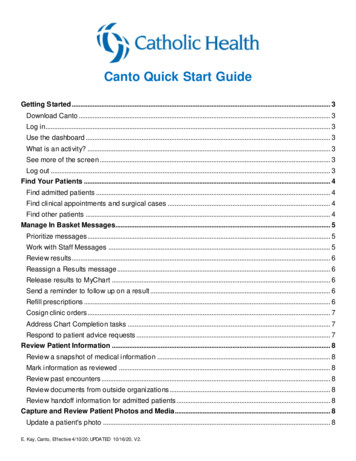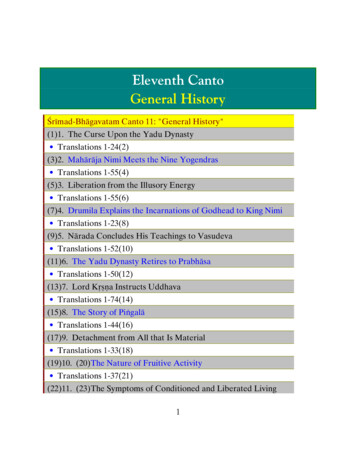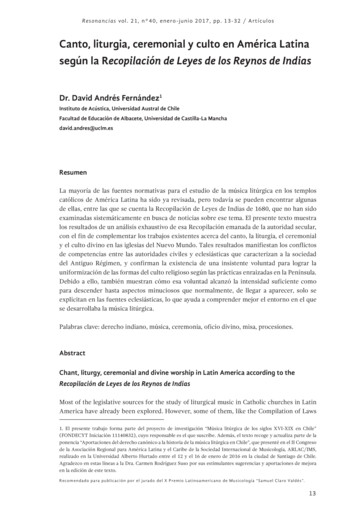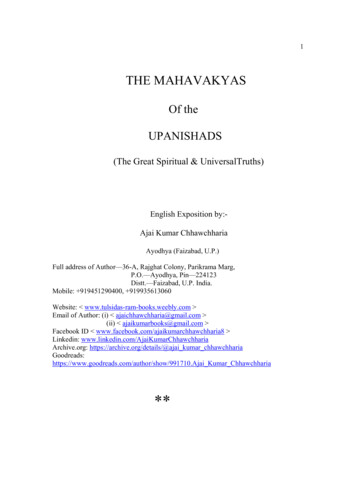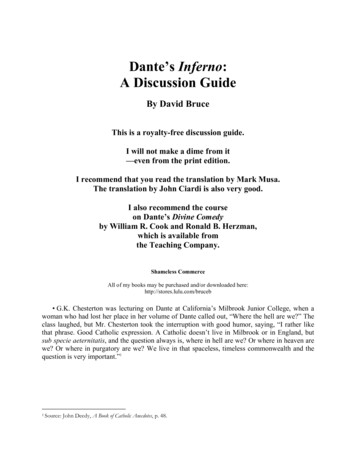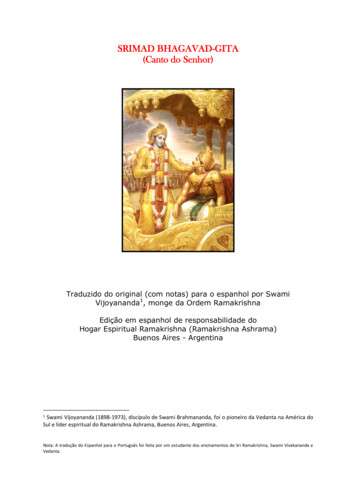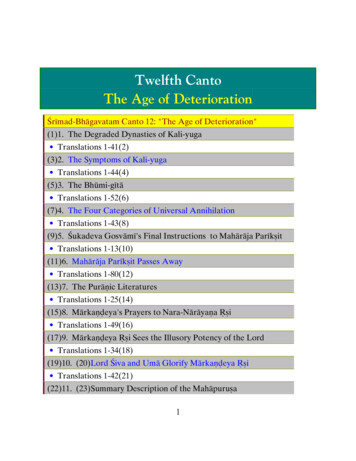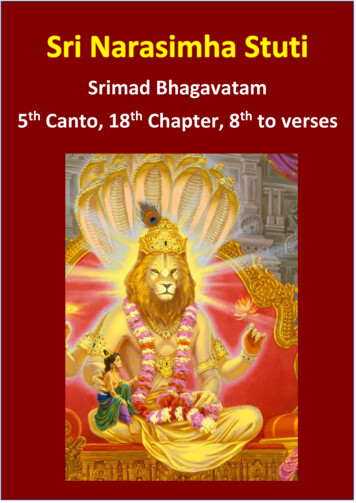
Transcription
Canto XXXIVCircle Nine: CocytusCompound fraudRound Four: JudeccaThe Treacherous to Their MastersThe CenterSatanHaving seen all, the Poets now climb through theKOn march the banners of the King,x Virgil becenter, grappling hand over hand down the hairygins as the Poets face the last depth. He is quoting aflank of Satan himself-—a last supremely symbolic acmedieval hymn, and to it he adds the distortion andtion—and at last, when they have passed the center ofperversion of all that lies about him. KOn march theall gravity, they emerge from Hell. A long climbbanners of the King—of'Hell."2 And there beforefrom the earttfs center to the Mount of Purgatorythem, in an infernal parody of Godhead, they see Saawaits them, and they push on without rest, ascendtan in the distance, his great wings beating like aing along the- sides of the river Lethe, till they emergewindmill. It is their beating that is the source of theonce more to see the stars of Heaven, just before dawnicy wind of Cocytus, the exhalation of all evil.on Easter Sunday.All about him in the ice are strewn the sinners ofthe last round, JUDECCA, named for Judas Iscariot.3 These are TREACHEROUS TO THEIR MASTERS. They lie completely sealed in the ice, twisted"On march the banners of the King of Hell,"and distorted into every conceivable posture. It is immy Master said. "Toward us. Look straightpossible to speak to them, and the Poets move on to obahead:serve So-tan.can you make him out at die core of the frozenHe is fixed into the ice at the center to whichshell?"flow all the rivers of guilt; and as he beats his greatwings as if to escape, their icy wind only freezes himLike a whirling windmill seen afar at twilight,more surely into the polluted ice. In a grotesque paro- 5 or when a mist has risen from the ground—dy of the Trinity, he has three faces, each a differentjust such an engine rose upon my sightcolor, and in each mouth he clamps a sinner whom herips eternally with his teeth. JUDAS ISCARIOT isstirring up such a wild and bitter windin the central mouth: BRUTUS and CASSIUS* inI cowered for shelter at my Master's back,the mouths on either side.there being no other windbreak I could find.1. Cocytus (ko si' tss): This Greek word means "wailing."2. On march the banners of the King—of Hell: The hymnwas written in the sixth century by Venantius Fortunatus,Bishop of Poitiers. The original celebrates the Holy Cross, andis part of the service for Good Friday to be sung at themoment of uncovering the cross.3. Judas Iscariot (is ker' e at): The disciple who betrayedJesus; see the Bible, Matthew 26:14, 48.4. BRUTUS and CASSIUS: They took part in a plot againstJulius Caesar.10 I stood now where the souls of the last class(with fear my verses tell it) were covered wholly;they shone below the ice like straws in glass.Some lie stretched out; others are fixed in placeupright, some on their heads, some on theirsoles;15 another, like a bow, bends foot to face.from the Inferno, Canto XXXIV641
When we had gone so far across the icethat it pleased my Guide to show me the foulcreature5which once had worn the grace of Paradise,he made me stop, and, stepping aside, he said:20 "Now see the face of Dis!6 This is the placewhere you must arm your soul against alldread."Do not ask, Reader, how my blood ran coldand my voice choked up with fear. I cannotwrite it:this is a terror that cannot be told.25 I did not die, and yet I lost life's breath:imagine for yourself what I became,deprived at once of both my life and death.The Emperor of die Universe of Painjutted his upper chest above the ice;so and I am closer in size to the great mountanthe Titans7 make around the central pit,dian they to his arms. Now, starting from thispart,imagine the whole that corresponds to it!35If he was once as beautiful as nowhe is hideous, and still turned on his Maker,well may he be the source of every woe!With what a sense of awe I saw his headtowering above me! for it had three faces:8one was in front, and it was fiery red;the right was something between white and bile;the left was about the color that one finds45 on those who live along the banks of die Nile.Under each head two wings rose terribly,their span proportioned to so gross a bird:I never saw such sails upon the sea.They were not feathers—their texture and theirformso were like a bat's wings—and he beat them sothat three winds blew from him in one greatstorm:it is these winds that freeze all Cocytus.He wept from his six eyes, and down three chinsthe tears ran mixed with bloody froth and pus.955 In every mouth he worked a broken sinnerbetween his rake-like teeth. Thus he kept threein eternal pain at his eternal dinner.For the one in front the biting seemed to playno part at all compared to the ripping: at times60 the whole skin of his back was flayed away."That soul that suffers most," explained myGuide,"is Judas Iscariot, he who kicks his legson the fiery chin and has his head inside.Of the other two, who have their heads thrustforward,65 the one who dangles down from the black faceis Brutus: note how he writhes without a word.40 the other two, as weirdly wonderful,merged with it from the middle of each shoulderto the point where all converged at the top ofthe skull;And there, with the huge and sinewy arms,10 is thesoulof Cassius,—But the night is coming on"and we must go, for we have seen the whole."5. the foul creature: Satan.6. Dis (dis): In greek mythology, the god of the lower world orthe lower world itself. Here it stands for Satan.7. Titans: Giant deities who were overthrown by Zeus and theOlympian gods of Greece.8. three faces: Numerous interpretations of these three facesexist. What is essential to all explanation is that they be seen asperversions of the qualities of the Trinity.9. bloody froth and pus: the gore of the sinners he chews,which is mixed with his saliva.10. huge and sinewy arms: The Cassius who betrayedCaesar was more generally described in terms of Shakespeare's"lean and hungry look." Another Cassius is described byCicero (Catiline III) as huge and sinewy. Dante probablyconfused the two.11. the night is coming on: It is now Saturday evening.642The Middle Ages
JUDECCA—LUCIFERQustave Dore70 Then, as he bade, I clasped his neck, and he,watching for a moment when the wingswere opened wide, reached over dexterously1'1and seized the shaggy coat of the king demon;then grappling matted hair and frozen crusts75 from one tuft to another, clambered down.When we had reached the joint where die greatthighmerges into the swelling of the haunch,my Guide and Master, straining terribly,turned his head to where his feet had beenso and began to grip the hair as if he were climbing,13so that I thought we moved toward Hell again.12. dexterously: Skilfully.13. as if he were climbing: They have passed the center ofgravity and so must turn around and start climbing."Hold fast!" my Guide said, and his breadi cameshrill14with labor and exhaustion. "There is no waybut by such stairs to rise above such evil."85 At last he climbed out through an openingin the central rock, and he seated me on the rim;then joined me with a nimble backward spring.I looked up, thinking to see Luciferas I had left him, and I saw instead90 liis legs projecting high into the air.Now let all those whose dull minds are still vexedby failure to understand what point it wasI had passed through, judge if I was perplexed.14. his breath came shrill: In Canto XXIII, 85, the fact thatDante breathes indicates to the Hypocrites that he is alive.Virgil's breathing is certainly a contradiction.from the Inferno, Canto XXXIVr643
95"Get up. Up on your feet," my Master said."The sun already mounts to middle tierce,13and a long road and hard climbing lie ahead."It was no hall of state we had found there,but a natural animal pit hollowed from rockwith a broken floor and a close and sunless air.And this gross Fiend and Image of all Evilwho made a stairway for us with his hideis pinched and prisoned in the ice-pack still.125And it may be that moved by that same fear,the one peak18 that still rises on this sidefled upward leaving this great cavern19 here."100 "Before I tear myself from die Abyss,"I said when I had risen, "O my Master,explain to me my error in all this:where is the ice? and Lucifer—how has hebeen turned from top to bottom: and how canthe sun105 have gone from night to day so suddenly?"And he to me: "You imagine you are stillon the other side of the center where I graspeddie shaggy flank of the Great Worm of Evil130 Down there, beginning at die further boundof Beelzebub's20 dim tomb, tiiere is a spacenot known by sight, but only by sound 115 Under the midpoint of that other skythe Man16 who was born sinless and who livedbeyond all blemish, came to suffer and die.You have your feet upon a little spherewhich forms the otiier face of the Judecca.120 There it is evening when it is morning here.15. middle tierce: According to the church's division of theday for prayer, tierce is the period from about six to nine A.M.Middle tierce, therefore, is seven-thirty. In going through thecenter point, they have gone from night to day. They havemoved ahead twelve hours.16. the Man: Jesus, who suffered and died in Jerusalem,which was thought to be the middle of the earth.644The Middle AgesOMy Guide and I crossed over and beganto mount that little known and lightless roadto ascend into the shining world again.140You are under the other hemisphere where youstand;die sky above us is the half opposedto that which canopies the great dry land.Oof a little stream21 descending through the hollowit has eroded from the massive stone135 in its endlessly entwining lazy flow."which bores through the world—you were while Iclimbed down,110 but I turned myself about, you passeddie point to which all gravities are drawn.s On tiiis side he plunged down from heaven's height,and die land that spread here once hid in the seaand fled North to our hemisphere for fright,17He first, I second, without thought of restwe climbed the dark until we reached die pointwhere a round opening brought in sight the blestand beauteous shining of die Heavenly cars.And we walked out once more beneadl die Stars.2217. fled North . . . for fright: Dante believed that theNorthern hemisphere was mostly land and die Southernhemisphere water. Here he explains the reason for this stateof affairs.18. the one peak: The Mount of Purgatory.19. this great cavern: The natural animal pit of line 98. It isalso "Beelzebub's dim tomb," line 131.20. Beelzebub's (be el' zs bubz): Beelzebub, which inHebrew means "god of flies," was another name for Satan.21. a little stream: Lethe (le' the). In classical mythology, dieriver of forgetfulness, from which souls drank before beingborn. In Dante's symbolism it flows down from Purgatory,where it has washed away the memory of sin from die soulswho are undergoing purification. That memory it delivers toHell, which draws all sin to itself.22. Stars: As part of his total symbolism, Dante ends each ofthe three divisions of the Divine Comedy with this word. Everyconclusion of the upward soul is toward the stars, God'sshining symbols of hope and virtue. It is just before dawn ofEaster Sunday that die Poets emerge—a further symbolism.
Reader's Response If you were Dante, whatthoughts would you have upon viewingSatan?THINKING ABOUT THE SELECTIONInterpreting1. Why are the figures in Satan's mouth consideredtraitors?2. Why does Dante choose to represent the most terrible part of Hell as a frozen lake?3. Why does Virgil have to carry Dante out of Hell byclimbing over Satan?4. Dante himself called punishment "the sword ofheaven." (a) First explain the meaning of this statement, (b) Then tell how it applies to Canto XXXIV.5. What does Dante learn from this experience?Applying6. What elements in Dante's depiction of the pit of Hellare designed to strike terror in the hearts of readers?This problem is heightened when the text is inverse, as it is in the Divine Comedy. The translatormust decide whether to use prose or poetry. If thetranslator uses verse, then will he or she use a poeticform that is familiar to the intended audience? If thereis a gap between what the audience expects and whatthe translator offers, it is usually because the style ofthe translation is not appropriate for its public.1. Imagine that you are John Ciardi preparing yourtranslation of the Inferno. Why did you decide totranslate it using verse instead of prose?2. Imagine that you are translating the work. Whatdecisions would you make that are different fromCiardi's?THINKING AND WRITINGPreparing TranslationsANALYZING LITERATUREUnderstanding PersonificationSatan is the quintessential representation of evil.In the Bible he is represented as a slithering serpent,hissing his treachery to Eve. In Dante's description ofSatan, he is the "Emperor of the Universe of Pain."However, he is rendered motionless in the ice. Hiskingdom and therefore his power is thus limited.1. Which details make Satan particularly repulsive?2. In what way does Dante's description of Satan indicate that evil is not necessarily frightening for theGodly human being?CRITICAL THINKING AND READINGAvoiding "Translationese"The translator is confronted with many problemswhen he or she begins to transfer a literary work fromone language to another. One of these problems ishow to avoid "transiationese"; or how to make a translation sound natural and appeal to a particular audience, while at the same time being faithful to themeaning of the original language.Reread these lines from the third canto:I AM THE WAY INTO THE CITY OF WOE.I AM THE WAY TO A FORSAKEN PEOPLE.I AM THE WAY INTO ETERNAL SORROW.SACRED JUSTICE MOVED MY ARCHITECT.I WAS RAISED HERE BY DIVINE OMNIPOTENCE,PRIMORDIAL LOVE AND ULTIMATE INTELLECT.ONLY THOSE ELEMENTS TIME CANNOT WEARWERE MADE BEFORE ME, AND BEYOND TIME I STAND.ABANDON ALL HOPE YE WHO ENTER HERE.Paraphrase Ciardi's translation of Dante. The simplest tool at your disposal is a dictionary of synonyms.For example, woe could be substituted by sorrow,pain, or tragedy. Forsaken could be replaced by thewords abandoned, forgotten, or forlorn. Try to findequivalent words for every important noun, verb, oradjective in this passage. Pick out the most striking orappropriate synonyms and then put them together tocreate your own version of the inscription. As yourevise your work, see if a different ordering of thematerial might be more effective or poetic. Do youthink your version conveys Dante's meaning well? Is iteasy to read and understand?from the Inferno, Canto XXXIVL645
GUIDE FOR INTERPRETINGfrom the Inferno, Canto XXXIV640CommentaryPersonification. Personification is the portrayal of a concept bygranting it a human identity. The Greeks and Romans personifiedphenomena by creating gods that evoked aspects of nature. Poseidon personified the sea and Apollo the sun.Dante uses both historical and mythological figures to represent the various sins. He goes to great lengths to fashion them anappropriate punishment. In fact, it is the punishment itself thatmakes the reader aware of the sins that these people have committed. A good example would be Paolo and Francesca. As Dantediscovers, they are the personification of lust. They are sweptaround this circle of hell just as they were swept away by their passions in life. This idea of appropriate punishment is linked to personification. Together, sin, its personification, and punishment create an allegorical system.Of course, Satan is the ultimate personification of evil. In him,evil is depicted as a hideous three-faced monster. He is frozen intothe very bottom of Hell, isolated as far as possible from God andhumanity, a suitable punishment for the cold-hearted betrayal of theultimate good.WritingFilms often personify evil. They may represent evil as a demonic car oras a plant. Create your own personification of evil.CommentaryThis is the end of an odyssey into Hell. But for Dante, this is merelythe first of three stages of his pilgrimage toward salvation. In the cantos you have read, you have seen how Dante creates a transitionfrom one circle of hell to another. Dante succeeds by making constant use of bridges, river crossings, and other images of travel.When he is confronted with an obstacle, Dante conveniently faints,allowing Virgil or his own narrative to carry him from one circle toanother.At the end of the Inferno, Dante must prepare for the continuation of his voyage in yet another realm. Satan is used as a bridgeover which Virgil and Dante climb into the next world. Virgil must carry the weakened Dante over the obstacle, as he did many timesbefore in the Inferno. What is new here is the contrast that Danteuses to lead his reader to a new world of hope and salvation. Hecontrasts the dark world of Hell with the dazzling light of Purgatory.And so he moves from the "lightless" to the "shining" world. Thisimage summarizes Dante's journey.The Middle Ages
from the Inferno, Canto XXXIV 643. s "Get up. Up on your feet," my Master said. 95 "The sun already mounts to middle tierce,13 and a long road and hard climbing lie ahead." It was no hall of state we had found there, but a natural animal pit hollowed from rock
